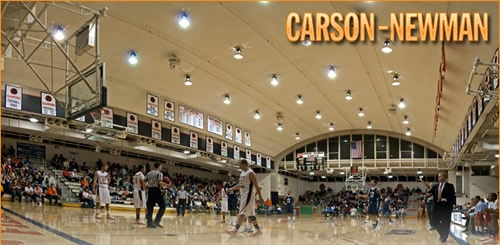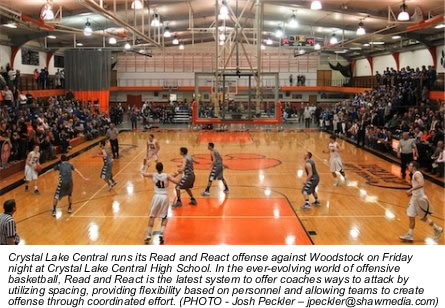18 Jan Tribe Spotlight: The next step in prep basketball’s evolution
Written By JOE STEVENSON (as appeared in the Northwest Herald on Sunday, January 13th, 2013) Every year, Rich Czeslawski heads to the NCAA Final Four to watch basketball, network and, perhaps most importantly, learn. Czeslawski had just finished his first season as Crystal Lake Central’s boys basketball coach in 2007 when he headed to Atlanta for the Final Four. While there, he attended a coaching clinic and caught a glimpse of the future. The clinician, Rick Torbett, is considered one of the foremost basketball teaching authorities in the world and distributes teaching videos on betterbasketball.com, many of which involve his Read and React offense. At that clinic, Czeslawski saw the future of his program with Read and React, an offense that can be taught in layers, offers flexibility against man or zone defenses and can be difficult to scout. In the ever-evolving world of offensive basketball, Read and React is the latest system to offer coaches ways to attack by utilizing spacing, providing flexibility based on personnel and allowing teams to create offense through coordinated effort. Dribble-Drive Motion, motion and Princeton are other popular ways that use some similar concepts. “We went to Read and React three years ago. It’s a very intelligent way of teaching a free-flowing offense,” Czeslawski said. “(Cary-Grove girls coach) Rod Saffert is running it. (Prairie Ridge boys coach) Corky (Card) is running it. I don’t really feel it’s a fad offense; it’s a way of teaching offense. You’re teaching offense and empowering players.”
While Czeslawski has had good talent with which to work in those three seasons, he thinks Read and React has helped the Tigers go 60-12 over that stretch.
When Czeslawski invited Torbett to Crystal Lake last summer, there were 40 coaches who attended a roundtable discussion to learn more about Read and React. Johnsburg boys coach Mike Toussaint was one of them, and while he had not fully implemented it with his varsity, the Skyhawks’ feeder program and lower levels are running it.
“We went to Read and React three years ago. It’s a very intelligent way of teaching a free-flowing offense,” Czeslawski said. “(Cary-Grove girls coach) Rod Saffert is running it. (Prairie Ridge boys coach) Corky (Card) is running it. I don’t really feel it’s a fad offense; it’s a way of teaching offense. You’re teaching offense and empowering players.”
While Czeslawski has had good talent with which to work in those three seasons, he thinks Read and React has helped the Tigers go 60-12 over that stretch.
When Czeslawski invited Torbett to Crystal Lake last summer, there were 40 coaches who attended a roundtable discussion to learn more about Read and React. Johnsburg boys coach Mike Toussaint was one of them, and while he had not fully implemented it with his varsity, the Skyhawks’ feeder program and lower levels are running it.
05 Dec A Forum Eulogy
There are a lot of things that differentiate Better Basketball from the rest of the basketball instructional market: we spend more time in development of our products than anyone else we've built the Tribe to offer ongoing support for coaches who have bought into our system we have...
13 Nov Drilling the Da Vinci Way
One of the questions I hear most often as a Read & React Coach is, "How often do you work on defense?" My answer is that we are almost ALWAYS working on defense. Very rarely do we work on offensive fundamentals or habits without introducing a defender to simulate a game situation. It is said that Leonardo Da Vinci could work with both hands independently, drawing with one while writing with the other. Inspired by this example, we thought it would be easier to collapse time frames if we gave drills both an offensive and defensive purpose. If you have assistant coaches, why not assign them to watch different sides of the ball? We call it the Da Vinci Way of drilling basketball. As an example, in our 3-Player drills, we always have a defensive emphasis. Once we teach the techniques we want used, we put 90 seconds on the clock and each group of 3 goes to a separate basket. To prevent players from 'going through the motions', we make it a competition and require each group to count out their makes. Coaches watch to make sure the offensive habits and defensive fundamentals are being followed and can subtract a point from that team's total if they are cutting corners. After 90 seconds we move to the other side of the court and repeat. At the end, the winning team breaks while the others do push ups, sit ups, etc. Here are two Layer 1 Drills that illustrate this idea.31 Oct Circle Movement Shooting
Many of our drills are designed to work the habit of Circle Movement even if we haven't yet taught Circle Movement in Layer 4. We do it in Full Court Trips during Trip 3 (Reverse Dribble), and our 'Circle Movement Shooting Drill' is another that does the same, which allows us to install it on Day 1. We normally run this for 10 minutes with half of the team on each end of the court, starting on the right side. We go 1:30 shot fake and drive, 1:30 shot fake-escape dribble jumper, and 2:00 catch and shoot. Then we switch ENDS (they are now all on the left side of court) and work back down. 2:00 catch and shoot, 1:30 shot fake-escape dribble jumper, 1:30 shot fake and drive. We use this drill to collapse time frames by emphasizing ball fakes before the pass, jump stop finishes, great closeouts, making great shot fakes, calling names out on passes, and covering ground with our dribble. All while training the habit of Circle Movement! [embed]http://www.fastmodelsports.com/library/embedImage.jsp?id=dfe0cf1b-ba48-40cb-a766-61c5d855dffd[/embed] We choose 2 different spots to start from each day to change the spots we shoot from as well as the passing and driving angles, but the drill stays the same. 2 things to watch:30 Oct Full Court Trips
Many in the Tribe have asked about the Full Court Trips Drill listed in the Master Practice Plan from my last post, 'Do You Have a Master Plan?' Since this is the first drill we do just about every practice, it is appropriate for it to be the first drill detailed in this series. We work on this drill every day of practice, and it has been invaluable to our program in making it a habit for our players to flow from our fast break directly into the Read & React. Our players love the opportunity to push the ball and score quickly, but if the defense gets back, we do not feel the need to pull the ball out and 'reset' in order to run offense. Here is a video excerpt from Planning the R&R Practice of our team running it, followed by the breakdown of the drill. To set up the video, I must mention that this was filmed at a Spring Clinic, and our team had been off for 2 months. It is not perfect, and we were using players from 3 different levels of our program. What I love about that is that they were all able to operate on the same page because of the Read & React curriculum we have installed. (If you don't have Planning the R&R Practice, it is an invaluable resource that we use all season long for ideas and information) Teaching Full Court Trips The way we install Full Court Trips, is to first teach our early offense. We use an Inbounder, an Outlet, 2 Lane Fillers (who cross if we don't pass the ball ahead) and a Rim Runner. The first 3 trips can be taught to all players at all levels regardless of Read and React experience.24 Oct Do You Have a Master Plan?
“The general who wins a battle makes many calculations in his temple before the battle is fought” -SUN TZU The questions that Read & React coaches collectively have on their minds as they begin their respective seasons seem to be centered around practice planning. For those who have the Planning the R&R Practice DVD Set, you are probably ahead of the game already, and have a great idea about how you want to operate your practices. The number one thing I am asked as a High School Read & React coach is, "How do you prepare for your first game with only 12 practices to do so?" We work very hard to collapse time frames and have put 3 years of trial and error into our Master Practice Plan. It outlines everything we want to cover prior to tipping off against our first opponent. We use this plan to stay on track while scheduling our individual practices, and alter it slightly each season based on the experience and skill level of the players we have returning. We view every drill in each practice as another brick we want to lay perfectly on our way to building something special over the course of the season. Please feel free to download the Master Practice Plan I use with our team. I will be discussing each brick in more detail beginning today. To further get the mental juices flowing, here are some past Tribe Posts with video that talk about practice planning:17 Oct A Phoenix with the Sickness of a Heretic
 Scott's flattering introductory post, Welcome To a New Beginning, made me pause to reflect on how I got my start in coaching. A devastating knee injury put an end to my playing career in high school and, unbeknownst to me at the time, laid the groundwork for the most rewarding and fulfilling career I could ever have hoped for. Like the mythical Phoenix, a bird reborn from its own ashes, I transformed from broken down player to aspiring coach.
It did not happen overnight. I spent my senior year as basically a student-coach, a conduit between my teammates and coaches. I enjoyed it and learned volumes about the different lenses players and coaches see the game through, but I still did not realize what my future held. Like most teenagers, I struggled to accept that everything happens for a reason. When I did come to terms with that idea, I thought it meant I should become a doctor. So I left the suburbs of Chicago for Arizona State University (providing a slightly ironic, albeit different, Phoenix reference) with the intent of studying medicine.
Scott's flattering introductory post, Welcome To a New Beginning, made me pause to reflect on how I got my start in coaching. A devastating knee injury put an end to my playing career in high school and, unbeknownst to me at the time, laid the groundwork for the most rewarding and fulfilling career I could ever have hoped for. Like the mythical Phoenix, a bird reborn from its own ashes, I transformed from broken down player to aspiring coach.
It did not happen overnight. I spent my senior year as basically a student-coach, a conduit between my teammates and coaches. I enjoyed it and learned volumes about the different lenses players and coaches see the game through, but I still did not realize what my future held. Like most teenagers, I struggled to accept that everything happens for a reason. When I did come to terms with that idea, I thought it meant I should become a doctor. So I left the suburbs of Chicago for Arizona State University (providing a slightly ironic, albeit different, Phoenix reference) with the intent of studying medicine.
13 Aug Sometimes we just need to be reminded…
...that we're on the right track. ...that we are making a difference. ...that what we're working on matters. ...of who we really are. Billy Graham once said, "One coach will impact more young people in a year than the average person does in a lifetime." So, with that in mind,...
01 Aug #rrtribe – Read & React Tribe Twitter Chat Monday at 8ET
Update: Last night was awesome. If you missed it, you can scroll through the live chat here or remember you can add to the conversation 24/7 by using the #rrtribe hashtag. Thanks to all that participated - I'll be posting a brief recap of the...







